By: Liron Kaplan, Konstantin Sinyuk
 What’s in Part 2 of the article
What’s in Part 2 of the article
In part 2 of the article, we will compare core features such as: CPU, Multimedia, Connectivity, Networking, Mechanical Size, Power Consumption, and Operating System while pointing out design limitations where relevant.
Click here if you missed Part 1.
CPU
As described in the overview section, all of the featured SoMs in this article are equipped with an i.MX6 processor based on ARM® Core. While VAR-SOM-MX6 , DART-MX6 , VAR-SOM-SOLO/DUAL are equipped with Cortex™-A9, the DART-6UL and the VAR-SOM-6UL are based on Cortex™-A7.
However, in each one of the SoMs reviewed in this article, there are a few different CPU options per product which allow further customization and price/performance optimization.
As a starter, the main difference between the CPU configuration options of the DART-6UL and the VAR-SOM-6UL is the CPU Clock, which ranges between 528MHz to 900MHz. The relatively new iMX6ULL options will allow further price and power consumption optimization, while the iMX6UL will add security features on its G2 and G3 options.
The VAR-SOM-SOLO/DUAL can also be optimized with a selection between the i.MX 6S (Single Core, 800MHz in Industrial Grade, 1,000MHz in Commercial Grade) and the i.MX 6DL (DualLite, 800MHz in Industrial Grade, 1,000MHz in Commercial Grade).
The DART-MX6 can be configured with either i.MX 6D (Dual Core, 800MHz) or i.MX 6Q (Quad Core, 800MHz). The VAR-SOM-MX6 which is bigger in mechanical size than the DART-MX6 can be configured with 1200MHz CPU (Dual and Quad core) and 1000MHz CPU in Commercial Grade.
In Industrial grade, the VAR-SOM-MX6 can reach 1000MHz (Dual and Quad) and 800MHz clock speed. As stressed before, the VAR-SOM-SOLO/DUAL, DART-MX6, and VAR-SOM-MX6 are all using the ARM Cortex™-A9 core.
| VAR-SOM-MX6 | DART-MX6 | VAR-SOM-SOLO/DUAL | DART-6UL | VAR-SOM-6UL | ||
|---|---|---|---|---|---|---|
| CPU | ||||||
| CPU Name | NXP iMX6 | NXP i.MX6 | NXP i.MX6 | NXP iMX6UL / iMX6ULL / iMX 6ULZ | NXP iMX6UL / iMX6ULL / iMX 6ULZ | |
| CPU Type | Cortex™-A9 MPCore™ | Cortex™-A9 MPCore™ | Cortex™-A9 MPCore™ | Cortex™-A7 | Cortex™-A7 | |
| CPU Cores | 1 – 4 | 2 – 4 | 1 – 2 | 1 | 1 | |
| CPU Clock (Max) | 1.2 GHz | 800 MHz | 1 GHz | 900 MHz | 900 MHz | |
| Integer performance (DMIPS) | 12000 | 8000 | 5000 | 1955 | 1955 | |
Memory
All Variscite’s SoM solutions include a variety of memory capacities. For example, while the DART-MX6 uses LP-DDR2, the other three i.MX6 platforms use DDR3/3L RAM.
The DART-MX6 LP-DDR2 lowers the overall system power consumption and can range between 1GB and 2GB. The VAR-SOM-MX6 supports DDR3 up to 4GB (mainstream up to 2GB), the VAR-SOM-SOLO/DUAL up to 2GB (mainstream up to 1GB), and the DART-6UL and the VAR-SOM-6UL up to 1GB (mainstream up to 512MB).
VAR-SOM-MX6, DART-MX6, VAR-SOM-SOLO/DUAL, DART-6UL and VAR-SOM-6UL MemoryRAM256 – 4096 MB DDR31024-2048 MB LPDDR2256 – 2048 MB DDR3128 – 1024 MB DDR3L
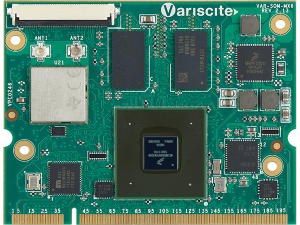
VAR-SOM-MX6 System on Module
On-Board Storage
There are two types of available On-Board storage in the iMX6 based platforms: SLC NAND and eMMC. The NAND storage is commonly used for Boot loader and OS Boot partition, while the eMMC is used for numerous kinds of user data. Historically, SLC NAND was used for operations that require high reliability such as described above. These days eMMC is a very common and reliable component that is also used by some platforms for booting and has better cost/capacity ratio above 1GB than NAND SLC.
On both the VAR-SOM-MX6 and VAR-SOM-SOLO/DUAL there are configurable options that allow the use of both SLC NAND and eMMC at the same configuration. In each of these SoM products, the eMMC is also completely removable to provide further cost optimization in configurations where significant Flash storage is not required.
Due to DART-6UL and VAR-SOM-6UL small size, only one of these two storage options can be configured per customer selection, ranging from 128MB-512MB SLC NAND, or up to 64GB eMMC. The exception in this area between the i.MX6 SoM products is the DART-MX6, which has no SLC NAND for Flash memory option. Thus, only eMMC is available in various configurations up to 64GB.
| VAR-SOM-MX6 | DART-MX6 | VAR-SOM-SOLO/DUAL | DART-6UL | VAR-SOM-6UL | ||
|---|---|---|---|---|---|---|
| Storage | ||||||
| Flash | Up to 512 MB NAND + 64GB eMMC | Up to 64GB eMMC | Up to 512 MB NAND + 64GB eMMC | Up to 512 MB NAND or 64GB eMMC | Up to 512 MB NAND or 64GB eMMC | |
Multimedia
In terms of Multimedia features, the DART-6UL and the VAR-SOM-6UL are inferior in performance, while VAR-SOM-MX6, DART-MX6, and VAR-SOM-SOLO/DUAL take the lead with enhanced Video Acceleration capabilities. These three SoMs are also equipped with HDMI, LVDS, and DSI interfaces, while the DART-6UL and the VAR-SOM-6UL natively support RGB display only (LVDS can be supported using external RGB -> LVDS bridge).
VAR-SOM-SOLO/DUAL, VAR-SOM-MX6, and DART-MX6 provide both Serial and parallel camera interfaces.
Between these three multimedia-ready SoMs, VAR-SOM-MX6 and DART-MX6 will provide higher-end multimedia performance and 3D capabilities thanks to an improved Graphics Acceleration Unit and higher LVDS resolution. VAR-SOM-SOLO/DUAL multimedia capabilities will be suitable only for applications that require entry level multimedia applications.
On the touch screen options, all four SoMs are very similar. The main difference is the lack of support for internal Resistive Touch on the DART-MX6, which can be added externally to the carrier board.
| VAR-SOM-MX6 | DART-MX6 | VAR-SOM-SOLO/DUAL | DART-6UL | VAR-SOM-6UL | ||
|---|---|---|---|---|---|---|
| Multimedia | ||||||
| Graphics Acceleration Unit | Vivante GC 2000 + Vivante GC 355 + Vivante GC 320 |
Vivante GC 2000 + Vivante GC 355 + Vivante GC 320 |
Vivante GC 880 + Vivante GC 320 |
2D pixel acceleration engine (PxP) | 2D pixel acceleration engine (PxP) | |
| Video Acceleration | 1080p60 H.264 Decode, 1080p30 H.264 Encode | 1080p30 H.264 Decode, 720p H.264 Encode | 1080p30 H.264 Decode, 1080p30 H.264 Encode | – | – | |
| Camera Interfaces | 1x CSI, 2x CPI | 1x CSI, 1x CPI | 1x CSI, 2x CPI | 1x CPI | 1x CPI | |
| HDMI | V1.4 1920 x 1080 | V1.4 1920 x 1080 | V1.4 1920 x 1080 | – | – | |
| RGB | – | – | – | 1366 x 768 24-bit | 1366 x 768 24-bit | |
| LVDS | >Dual 1920 x 1200 24-bit | >Dual 1920 x 1200 24-bit | Dual 1366 x 768 24-bit | – | – | |
| DSI | 1280 x 720 24-bit | 1280 x 720 24-bit | 1280 x 720 24-bit | – | – | |
| Resistive Touch | 4-wire Touch | External | 4-wire Touch | 4-wire Touch | 4-wire Touch | |
Connectivity
All i.MX 6 based modules from Variscite include a wide variety of serial interfaces, supporting multiple UART, SPI, I2C and CAN BUS interfaces. All modules support 2x USB.
The VAR-SOM-SOLO/DUAL, VAR-SOM-MX6, and DART-MX6 also add high-speed PCI-Express, and the VAR-SOM-MX6 and DART-MX6 also support the SATA interface.
| VAR-SOM-MX6 | DART-MX6 | VAR-SOM-SOLO/DUAL | DART-6UL | VAR-SOM-6UL | ||
|---|---|---|---|---|---|---|
| Connectivity | ||||||
| SD / MMC | x1 | x1 | x1 | x1 | x1 | |
| USB Host / Device | USB 2.0: 1x Host, 1x OTG | USB 2.0: 1x Host, 1x OTG | USB 2.0: 1x Host, 1x OTG | USB 2.0: 1x Host, 1x OTG | USB 2.0: 1x Host, 1x OTG | |
| S-ATA | SATA II interface, 3.0 Gbps | – | – | – | – | |
| UART | 5, up to 3.6 Mbps | 3, up to 3.6 Mbps | 5, up to 3.6 Mbps | 8, up to 3.6 Mbps | 8, up to 5 Mbps | |
| I2C | x2 | x2 | x4 | x4 | ||
| SPI | x2 | x2 | x2 | x4 | x4 | |
| CAN Bus | x2 | x2 | x2 | x2 | x2 | |
| ADC | – | – | – | 12-bit 2 x 10 channel | 12-bit 2 x 10 channel | |
| One-Wire | – | – | – | – | – | |
| RTC | on carrier | on carrier | on carrier | on carrier | on carrier | |
| PCI-Express | Gen 2.0 | Gen 2.0 | Gen 2.0 | – | – | |
| External Bus | EIM | EIM | – | – | – | |
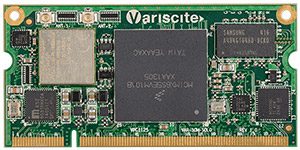
VAR-SOM-SOLO/DUAL System on Module
Networking
To optimize costs, each one of the SoMs reviewed in this article can be configured and ordered with or without the Wi-Fi/BT and Ethernet PHY (DART-6UL and VAR-SOM-6UL can also support dual ETH).
On VAR-SOM-SOLO/DUAL, VAR-SOM-MX6 and DART-MX6 customers have the option to choose between Single or Dual Band Wi-Fi 802.11a/b/g/n with or without MIMO, all based on TI’s WL183XMOD certified combo module. The DART-6UL and the VAR-SOM-6UL include Single or Dual Band Wi-Fi 802.11ac/a/b/g/n based on LSR/Laird’s Sterling LWB/LWB5 certified combo module.
Each Wi-Fi configuration option selected by the customer will also include Bluetooth supporting BT5.2/BLE.
All of the four SoMs include one or two u.FL connector(s) to enable an easy connection of the customer’s specific antenna(s) for his own specific end product design.
| VAR-SOM-MX6 | DART-MX6 | VAR-SOM-SOLO/DUAL | DART-6UL | VAR-SOM-6UL | ||
|---|---|---|---|---|---|---|
| Networking | ||||||
| Ethernet | 10/100/1000 Mbps | 10/100/1000 RGMII | 10/100/1000 Mbps | 10/100 Mbps + 10/100 RMII | 10/100 Mbps + 10/100 RMII | |
| Wi-Fi | 802.11 a/b/g/n (MIMO) | 802.11 a/b/g/n (MIMO) | 802.11 a/b/g/n (MIMO) | 802.11 ac/a/b/g/n | 802.11 ac/a/b/g/n | |
| Bluetooth | 4.2 / BLE | 4.2 / BLE | 4.2 / BLE | 5.2 / BLE | 5.2 / BLE | |
Mechanical size/dimensions
The DART-MX6 is the smallest size between all i.MX6 based platforms. This SoM’s impressive performance in such a small form factor is enabled by an assembly method known as Package on Package (PoP), which assembles the LP-DDR on top of the CPU package. This allows space to be saved on the circuit but limits the available CPU frequency to 800MHz due to power dissipation limitations.
Another small form factor SoM in this group is the DART-6UL, which together with its very low power consumption makes this specific SoM an excellent choice for a Handheld Battery-operated device.
Both VAR-SOM-SOLO/DUAL and VAR-SOM-MX6 arrive in larger dimensions per the table below. It is important to note that these two SoMs are pin2pin. Depending on the entry point requirements of the project, this pin2pin compatibility can allow engineers who find these platforms suitable to their project to define a scalable product line without changing their carrier board and general system design.
| VAR-SOM-MX6 | DART-MX6 | VAR-SOM-SOLO/DUAL | DART-6UL | VAR-SOM-6UL | ||
|---|---|---|---|---|---|---|
| Mechanical Specifications | ||||||
| Dimensions (W x L x H) | 51.5mm x 68mm x 4.5mm | 20.0mm x 50.0mm x 4.0mm | 35mm x 68mm x 4.5mm | 25mm x 50mm x 4.0mm | 67.6mm x 33mm x 4.5mm | |
Operating System
All featured SoMs can work and perform well with a Linux OS (Yocto & Debian). With regards to Android, VAR-SOM-SOLO/DUAL will provide entry level Android support for products requiring a limited number of applications, while the VAR-SOM-MX6 and DART-MX6 are optimal for higher end Android-based products with multiple applications and high-end graphics.
Variscite provides its customers with free access to the BSP/drivers source code.
Complete documentation of the available operating systems with detailed examples can be found inside www.variwki.com.
| VAR-SOM-MX6 | DART-MX6 | VAR-SOM-SOLO/DUAL | DART-6UL | VAR-SOM-6UL | ||
|---|---|---|---|---|---|---|
| OS Support | ||||||
| Linux | Yes | Yes | Yes | Yes | Yes | |
| Android | Yes | Yes | Yes | Brilo | Brilo | |
| Windows | WEC 7.0 / 2013 (Third Party) |
– | – | – | – | |
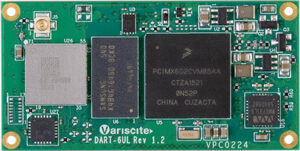
DART-6UL SoM
Additional Features Comparison
| VAR-SOM-MX6 | DART-MX6 | VAR-SOM-SOLO/DUAL | DART-6UL | VAR-SOM-6UL | ||
|---|---|---|---|---|---|---|
| Audio | ||||||
| Headphone driver | Yes | Yes | Yes | Yes | Yes | |
| Microphone | Digital | Digital | Digital | Analog | Analog | |
| Digital audio serial interface | S/PDIF | S/PDIF | S/PDIF | SAI, S/PDIF | SAI, S/PDIF | |
| Line In/Out | Yes | Yes | Yes | Yes | Yes | |
| Electronic Specifications | ||||||
| Supply voltage | 3.3 V | 3.3 V | 3.3 V | 3.3 V | 3.3 V | |
| Digital I/O voltage | 3.3 V | 3.3 V | 3.3 V | 3.3 V | 3.3 V | |
| Temperature Grades | ||||||
| Commercial (0 to 70°C) | Yes | Yes | Yes | Yes | Yes | |
| Extended (-20 to 70°C) | Yes | (-20 to 85°C) | Yes | – | – | |
| Industrial (-40 to 85°C) | Yes | Yes | Yes | Yes | Yes | |
Summary
The goal of this article is to provide technical comparison points that can assist the common developer in choosing the most suitable SoM for his target application and end product.
As described in this article, the main differences between the iMX6 based SoMs revolve around the range of options in regards to size, power, CPU, multimedia capabilities, and interfaces. That said, each SoM also has numerous configuration options that the customer can select to optimize cost and performance in his specific end product.
Not sure what’s the right solution for your project?
Leave us a note and our team will help you find the best solution that meets your needs: contact us
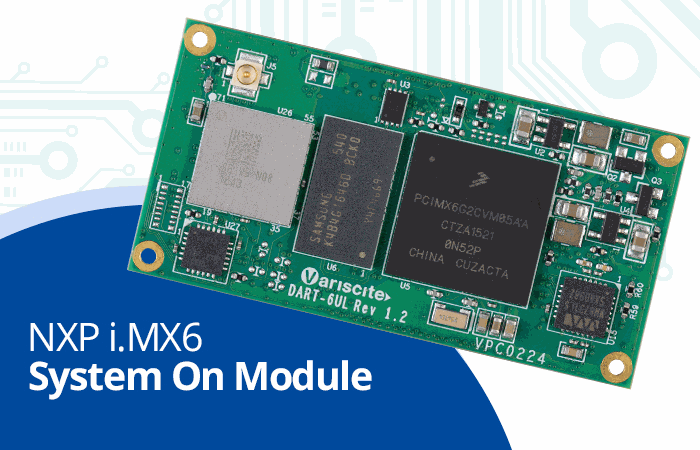
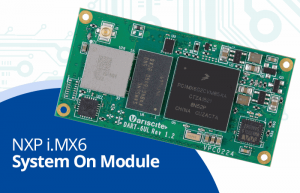 What’s in Part 2 of the article
What’s in Part 2 of the article